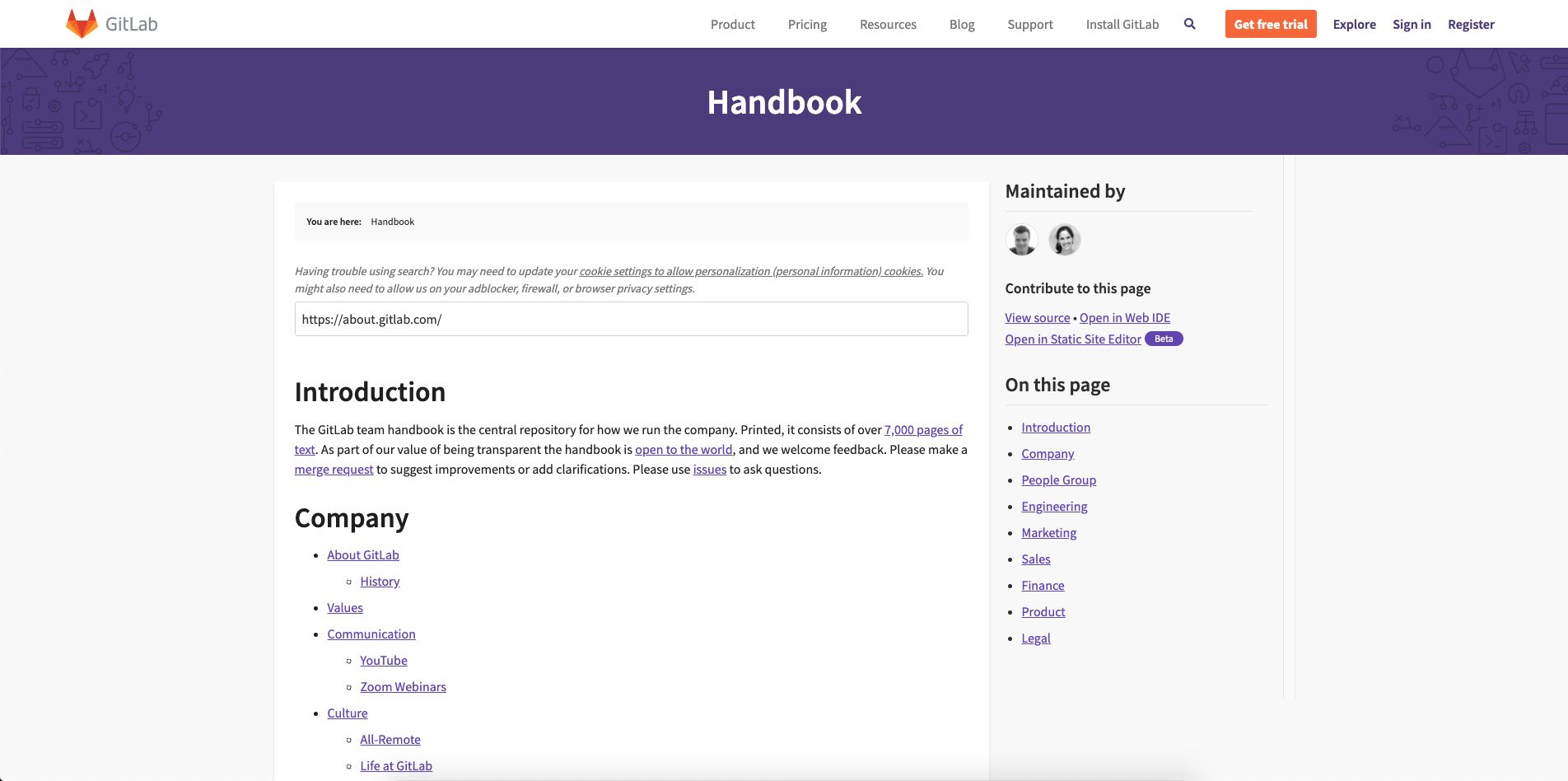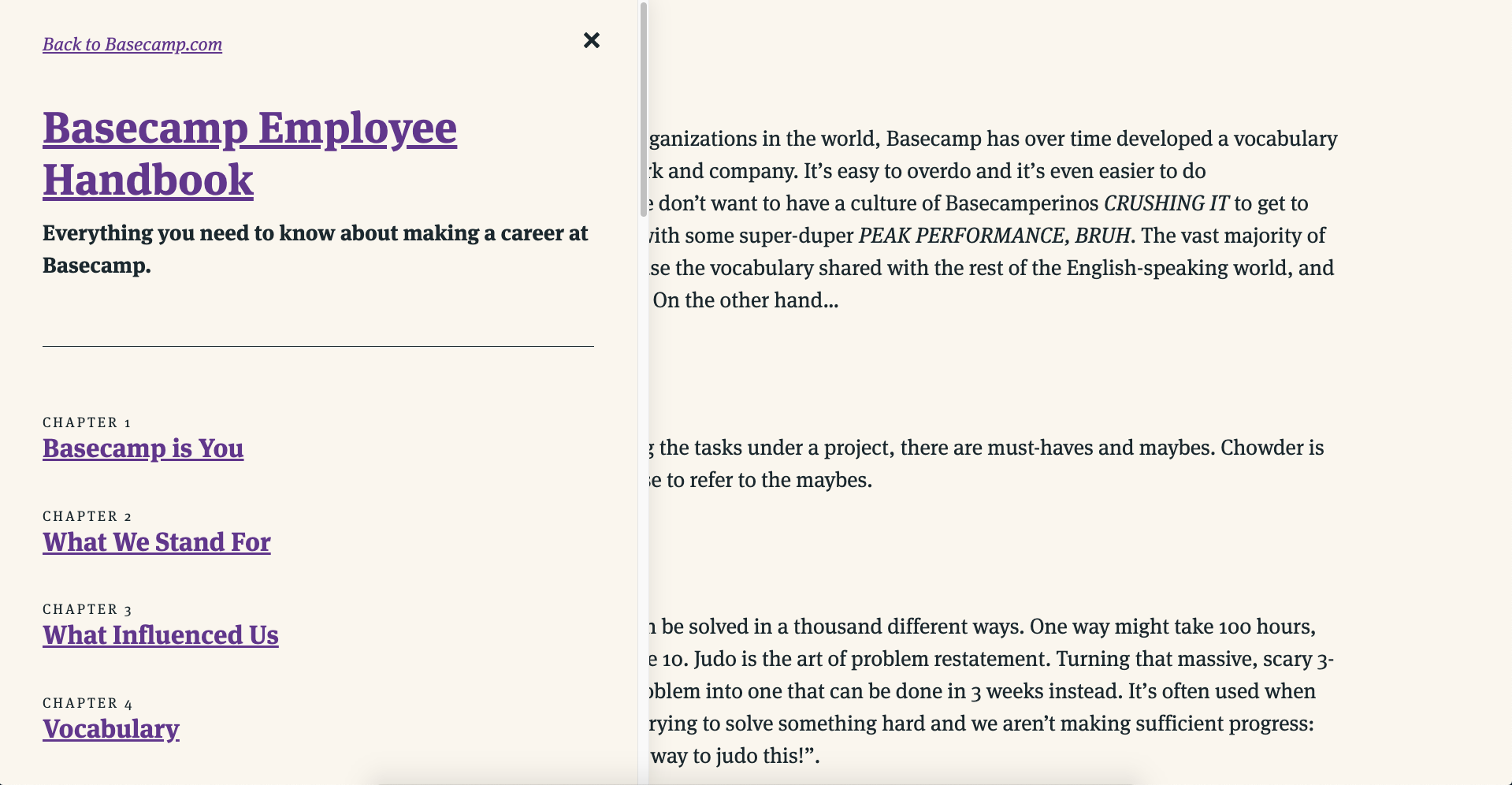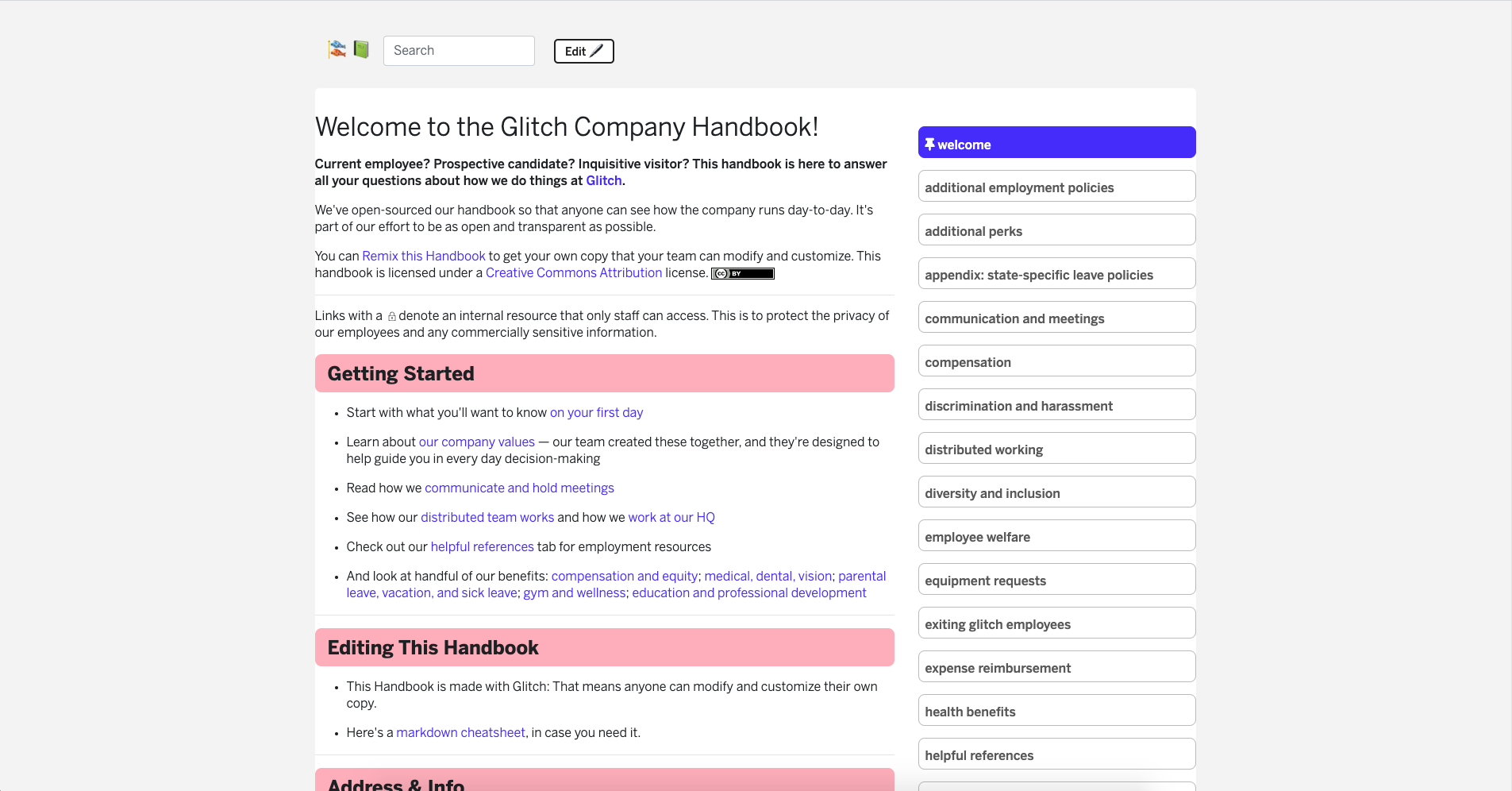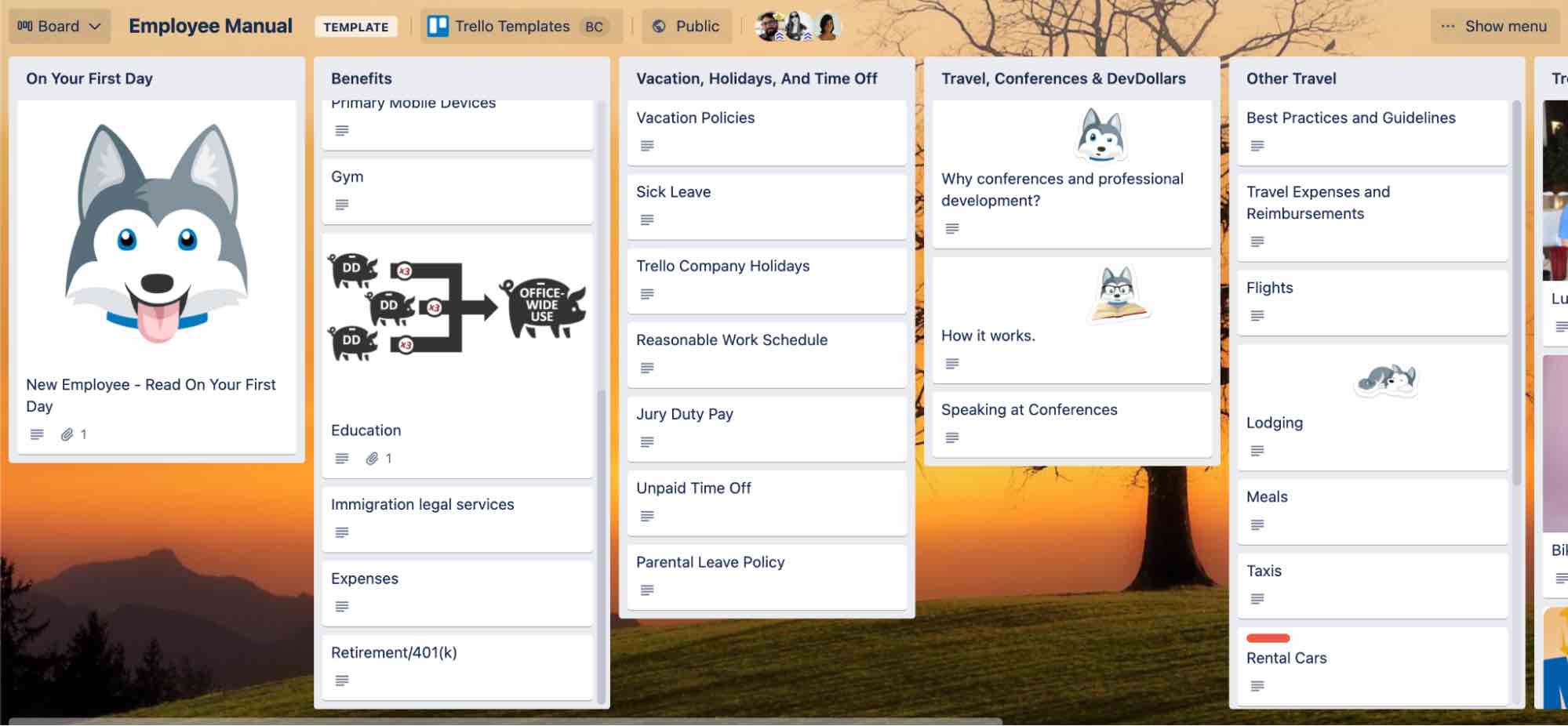You ever see a remote company you want to work for, or just shop from, and you’re curious about them? You want to know more about them. Who are they? What do they do? How are they making this nice leather bag? What’s in it for me as an employee? Many, many questions.
Employee handbooks are a crucial part of human resources. They show new hires the information they need, can be the go-to place to record new policies in and when made public, and are an excellent way to give people a glimpse into your company culture.
Before we get started on examples of our best employee handbooks, it’s only fair that we cover some preliminary information first–to rule out any confusion and ensure clarity.
What Is an Employee Handbook?
An employee handbook, also known as an employee field guide or staff manual, is an informative handbook talking on company culture, rules and policies, best practices, and everything else a new hire would need to know on their first day.
Great employee handbooks can also be used as a reference for an employees’ day-to-day. For example, they can better understand a brand’s voice and vision to deliver better work or check up on a policy to ensure they’re abiding by company guidelines.
Employee handbooks are essential communication tools for remote companies that want their teams to be aligned on corporate vision and other processes.
What Do The Best Employee Handbooks Include?
Every company is different in its core values, voice, and vision. Overall, their employee handbooks, then, should reflect their unique touch. For example, a company with a goofy and playful culture may use more slang, creative copy, and conversational language in its handbook.
The written style is the first indicator of what type of company you are. So, do an excellent job writing with a personality that’s coherent with your brand.
Some other things you should include in your employee handbook are:
- Mission statement–your employee handbook should state why you started the company and how you’re accomplishing your mission.
- Culture guides–an outline of the behaviors and beliefs a company practices internally and outside business transactions. This could be communicated through a list of core virtues and mandatory personality traits.
- Legal policies–informing employees on their rights and obligations–like a vacation policy, medical leave, dress codes
- Realistic expectations–what the company and employees expect from each other–can include pay, workload, luxuries, etc.
- Extra company policies, case studies, or reports on corporate social responsibility–like support for minority communities.
Why Is an Employee Handbook Important?
It’s not a legal requirement to create an employee handbook. Sure, you may be legally required to inform your employees of their workplace rights and entitlements, but it doesn’t have to be through employee handbooks.
Yet, it seems as though every company has one. The truth is, an employee handbook helps bridge the growing communication gap between corporate and your employees as the company gets bigger. Creating a comprehensive handbook that covers critical information, key policies, and frequently asked questions is a wise decision to mitigate conflict.
Beyond solving employee-corporate miscommunication, a company handbook can make new employees feel at home by giving a glimpse into what you’re all about. Learning about a company’s stories, past adventures, and mission statement can inspire more engagement and loyalty from the employee, too, since they find something to resonate with and be proud of.
Without further ado, let’s bring out the employee handbook examples:
GitLab's Collaborative All-Remote Handbook

We have to mention the incredible work GitLab has been doing to make its employee handbook open and collaborative. With over 3,000 pages and growing, it's the most extensive remote work handbook in the world. The investment into the handbook didn't only pay off in terms of transparency in the human resources department – it's also a marketing feat that promotes GitLab and its work ethic on millions of Google search terms related to remote working. The handbook alone nets the GitLab domain millions of backlinks. Impressive!
Marketing aside, the all-remote employee handbook by GitLab has become a remote work encyclopedia. Be it in interviews about GitLab or in any kind of coverage about the remote work movement, there’s probably an article or quote in the handbook that can be used as a reference. As a prospective applicant or employee, it's calming to know that all information is stored somewhere in that extensive compendium.
Not only that, but GitLab's handbook runs on Git through GitLab. That means that any collaborator can take a page out of the handbook, edit it or add a section, open a Merge Request and get it approved. A big issue with handbooks is that they fall out of date often. If you give moderated access to your over 1,000 employees and keep the handbook as the primary record for information, it's much less likely for that to happen.
Basecamp's Straight-to-the-Point Handbook on Github
Basecamp's strategy for their employee handbook is much more straight to the point. As part of their refreshed handbook experience, they have created a small slideshow that goes over 15 main chapters from their history to their travel guides and moonlighting policy.

Until a few months ago, this information has also lived primarily on a Git-powered medium through GitHub. As you can see on the repository, Basecamp's handbook isn't quite as informative and extensive as GitLab's, which also leads to a lot less collaboration. That's fine, though – pull requests on Basecamp's handbook usually reflect over-arching changes to a specific policy, such as changes to the profit-sharing program or a difference in the requirements for a particular position.
Even if there is a little less content, it makes the utility of Basecamp's employee handbook no less. It captures the key policies and internal quirks of the company’s culture without filling the handbook up with unnecessary clutter. Also: Basecamp's team is around 20x smaller than GitLab's, so it's no surprise that the handbook is a little lighter too.
Clef's Handbook for Inclusion and Value-Driven Culture
Clef may not exist in its current form anymore, but their universally accessible and effective employee handbook has sparked interest either way. It reads like a blueprint for future value-driven and people-first companies and therefore is a great starting point for remote companies.
The handbook repository of Clef is fully packed with goodies. Their bias-aware compensation structure to an end-to-end onboarding example includes countless files that have lived through hundreds of iterations by over 30 contributors. Amazing!
Today, almost 3,000 people have marked this repository with a Github star. As companies realize that being "value-driven" is more than just clever marketing, it's probably growing to grow a lot further.
Especially for small companies that may not have too much power to stand out from the crowd, a handbook like this will keep readers engaged and be your number one funnel to receive exciting and diverse applications.
Glitch's Interactive Handbook
Glitch has a long history and has built their own little nook on the internet since they started in 2000. It's very on-brand therefore that their handbook is built entirely on Glitch as well. With that, they are the only handbook in this list that does not rely on the Git protocol. Instead, changes are done through the Glitch editor directly. The handbook can be "remixed" in order to be used for your own company and just like we've seen before, there are multiple chapters that make up the handbook.

Content-wise, the Glitch handbook is similar to the Basecamp one. Policies are strict and to the point. There is not much content to be read on the ins and outs of their working structure. That's not a bad thing. A new hire could get through the handbook on their first onboarding day or during a few off-hours throughout their first week.
Toptal’s Tip-Centric Handbook

Toptal has over a decade of experience operating as a remote company. They share their learned lessons on tech, productivity, and culture with employees and other companies through their own handbooks to help navigate the new remote-work world.
Their employee handbook is genuine, tip-centered, and human. The company took the time to interview and quote several team leaders and executives to weave into different sections. New employees now get an idea of the people they’re working for and can use them as inspiration.
In addition to focusing on what the employee must know and tips, Toptal also shares what it’s like on the other side of the table for human resources. That includes sourcing talent, setting goals, mentoring, and career development. This encourages a more sincere bond with employees because they see past the corporate veil into a proper and growth-centric management.
Hanno’s Operational Blueprint Handbook
Sometimes when your product or service is creation-heavy, the best way to connect with employees or customers is through operational transparency. How do you do what you do? You may be the nerds but, providing an easy-to-grasp outline of your process to your clients shows that you want them involved, that you care. And it gives employees a glimpse of what they can expect.
Especially in dire times like these where stay-at-home orders mean life and death, remote work onboarding is crucial for companies. Since you can’t exactly take new hires through a walk in the park and show them around, a great employee handbook outlining the creative process is what you may need to get your new employees excited and adjusted to the work culture.
Unlike the other employee handbook examples, Hanno’s table of contents outlines their organizational structure; it looks like this:
CONTENTS
Each section goes in-depth with sub-headings featuring company examples, case studies, and research to help explain things.
Trello’s Trello

Trello’s employee handbook is not your average dedicated webpage, nor is it a pamphlet. Trello’s employee manual is a, well, Trello dashboard. Unlike many companies out there, Trello displayed all company-related specifics using their own service to showcase the service’s utility and organizational forte naturally.
The tech company has a unique approach to demonstrating loyalty to the company; using your own service to create deliverables? Talk about walking the talk. Each board covers a different topic.
The first board is placed for the onboarding process of new employees and contains a directory of other policy pages and notes regarding their day-to-day privileges–which, by the way, are very nice.
Trello is staff-centered as its frontline boards are all dedicated to employee benefits and policies. Creating your employee handbook with the help of your software not only looks badass, but it instills confidence in your employees because they’ll honestly believe in the product.
Remember to add a remote work policy to your employee handbook
The best employee handbooks never go out of date. If there’s anything Github’s example taught you, it’s that you have to adjust to change. In the pandemic world, working with team members in real life is not feasible and temporarily irrelevant.
Stay-at-home orders, then, naturally call for a remote work policy. You can’t lose control of your existing employees and especially not of any new hires. So, you need to update your working from home policies in your employee handbook to avoid miscommunication.

If we bring back Trello for a moment, they’ve thoroughly covered their remote work policy. For example, as a clueless employee who hasn’t a clue on how to navigate the remote work life, they can read the policy and learn that a stable internet connection, headset, and dedicated room are essential.
Parting Words
Hopefully, now you understand the importance of creating a handbook and how to design one by mimicking the best employee handbook examples. Your story starts somewhere; the best handbook will be a part manifesto and part employee handbook.
Remember, your overall goal with an old-school employee handbook is to showcase workplace culture, highlight core values, outline your company mission, and of course, be informative on employee-related instructions, best practices, and company policies. New team members will thank you for doing so.
Frequently Asked Questions
Why is company culture important in handbooks?
You need to ensure that new hires are a cultural fit for the company if you want your business to thrive. An employee that aligns with company values will serve customers best by meeting expectations and upholding the brand name.
You’ll have a better chance at fostering that great culture if you outline what you’re looking for in your handbook since not everything is legally mandated in the employment contract.
Do existing employees need an employee manual?
Yes. We know that being a long-term asset to company history often makes employees a little cocky and thinks they’re experienced. While they may know what they’re doing, an employee guide or handbook never hurts to use as a reference occasionally. We all make mistakes.
And, like with the remote work policies, companies are constantly changing due to circumstances. Updating handbooks offer new information even for existing employees.
Does a small business need employee handbooks?
Not always, but a great employee handbook is always recommended. Handbooks can save an organization thousands of dollars in legal costs by clarifying policies, like employee leave–which is incredibly foggy for smaller businesses.
Your business is bound to grow. Why take on the hassle of creating a manual when you will be busier than get it out of the way now and update it constantly?
